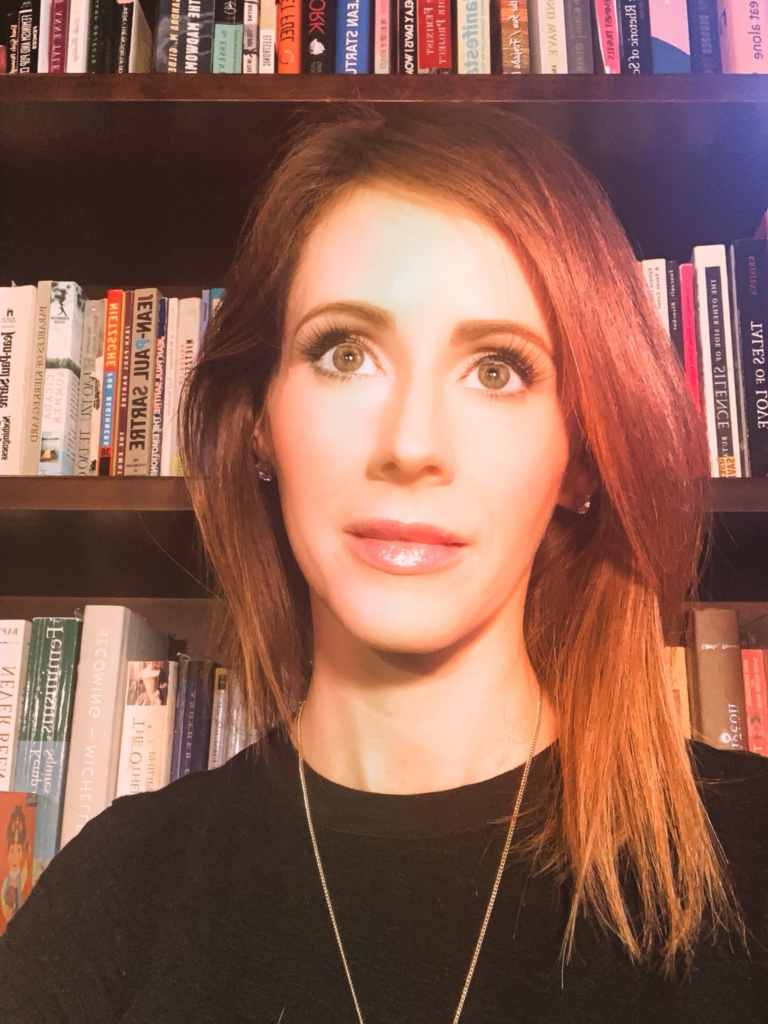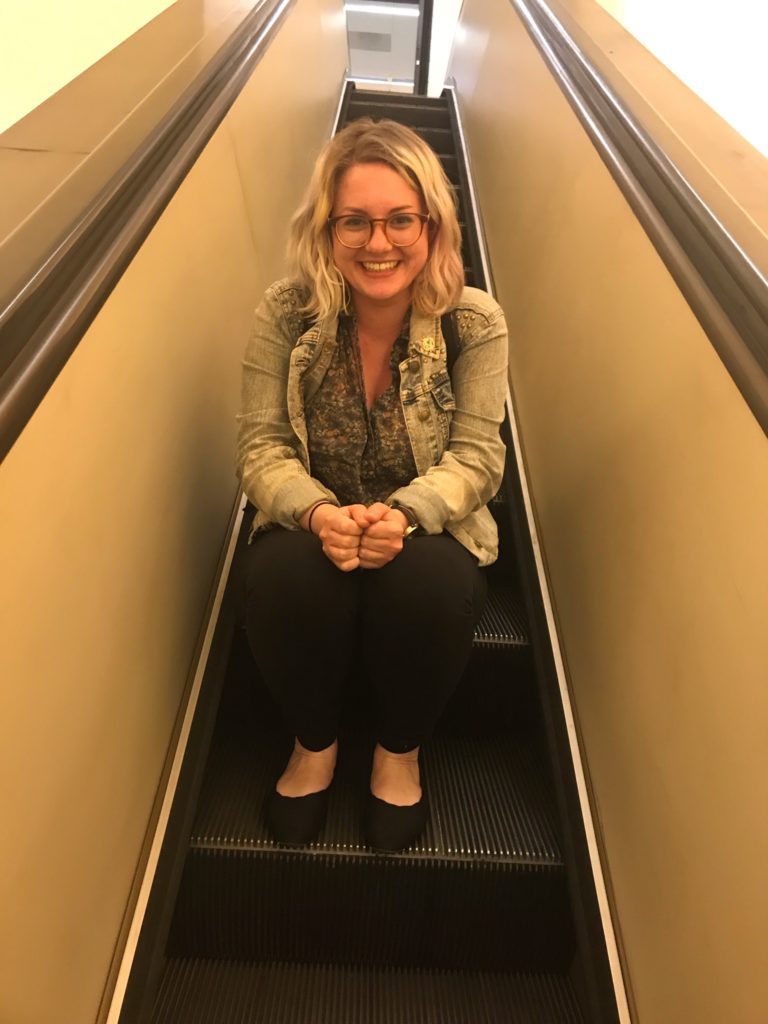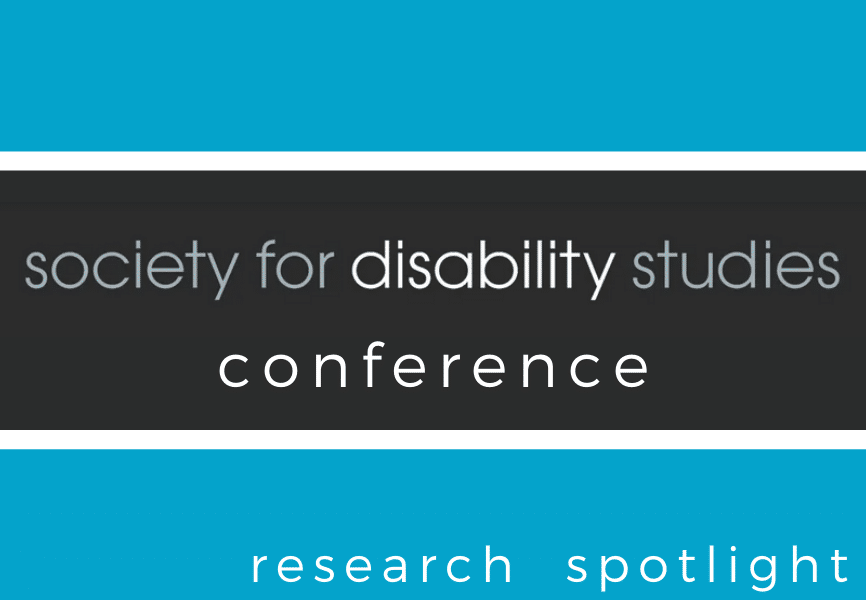In light of global COVID-19 responses, many academic conferences have been canceled to limit large public gatherings and travel. The Society for Disability Studies (SDS) Conference, however, transformed itself for virtual accessibility. The conference theme “Troubling Binaries of Activism and Academics” asked participants to “reexamine the construct and intentions of activism and scholarship,” but the conference quickly found itself facing the impact of another binary: that of the scheduled physical conference and shifting to an entirely digital one.
Two members of the WRD community applied and were accepted to SDS 2020 and attended their virtual conference on April 4-5. Neither Adjunct Instructor Erin MacKenna-Sandhir or second-year masters student Rachel Larrowe had attended this conference before, and for both, this would be their first virtual conference.
Erin and Rachel shared their experiences at this conference with us, from their original interest to how they prepared, to the content of their research, and attendance of the conference.
What Piqued Their Interest
Erin MacKenna-Sandhir originally became interested in the “intersections between writing studies and disability studies” a few years ago when she read Shannon Walters’ “Muscular Drooping and Sentimental Brooding: Kenneth Burke’s Crip Time-War Time Disability Pedagogy” in a 2018 issue of the College Composition and Communication Journal.

— Erin Mackenna-Sandhir
“This [essay] encouraged me to reflect on how my own practices might rely on ableist narratives,” Erin shared. “Composition classrooms, because they are focused around critical literacies, can benefit from disability pedagogies.”
Rachel Larrowe is a second-year grad student who conducted an independent study with Dr. Erin Workman during the 2020 Winter quarter, titled “Disability Rhetorics.” This independent study aligned with the SDS call for papers, which Rachel said was helpful in structuring her project.
“I had to write the proposal before I even really planned my [independent study] reading list,” she said. “Once I’d submitted the proposal, I knew where I was planning to end up, and built my reading list towards that goal.”
Rachel’s interest in this conference also stemmed from her interest in the keynote. “I was really interested in listening to other disability studies scholars and becoming part of that conversation,. I had just read Leah Lakshmi Piepzna-Samarasinha’s book Care Work: Dreaming Disability Justice… [and] she was the keynote speaker.”
SDS aims to ask questions like “How are activism and study defined within academic and community spaces?” and “What are the specific contexts in which people engage in “activist” and “academic” roles?” questions that both Rachel and Erin sought to answer within their own research.
Their Research
“Intersectional Frames for Social Action: From ACT UP to Disability Rights Activism”
— Erin MacKenna-Sandhir
Erin’s project, “Intersectional Frames for Social Action…” was an extension of a similar paper that she presented at the Feminisms and Rhetorics Conference at The University of Dayton in 2017. “In both papers,” she shared, “I’m hoping to advance the idea that whenever social movements seek to diversify their coalitions and bridge racial division, their rhetorical discourses must include intersectional frames.”
Erin analyzed the rhetorical labor that led to the development of intersectional frames for the 1988 FDA protest organized by the AIDS Coalition to Unleash Power (ACT UP). She shared that, “The framing of AIDS as a public health crisis rather than a private medical matter was paramount to congressional action and to winning the coalition’s demand that the FDA shorten the approval process and make safe drugs immediately available to all groups of HIV positive and AIDS sufferers including people of color and gay men”
Her paper also identified the promise of inclusive rhetoric germinated in the 1977 Section 504 sit in and puzzled over why those intersectional frames could not be sustained in disability rights rhetoric of the 1980s.
While not initially included in her project, Erin also brought these case studies in line with the current rhetorical situation surrounding COVID-19.
“We already know that some communities are more vulnerable to the virus than others for reasons, at least in part, related to unequal access to health-based resources in America. As the pandemic attacks inmates in prisons, disabled people in assisted living facilities, and black folks in urban areas, effective rhetorical frames aimed at providing just care for these populations will need to neutralize the ableism, ageism, xenophobia, and racism that already pervade our frameworks for calculating which lives are grievable and which disposable… Intersectional framing in this context will need to articulate shared values across diverse communities of stakeholders at the same time that those communities are pushed to view each other with suspicion.”
“BPD, CPTSD, and Identity: The Discursive Construction of Diagnostic Possibilities”
— Rachel Larrowe
Rachel’s project “BPD, CPTSD, and Identity…” explores how “identities are constructed in relation to psychiatric diagnoses, specifically with regard to borderline personality disorder and complex post-traumatic stress disorder.” Rachel conducted a discourse analysis of the DSM-5 to show how “differently the two diagnoses, and perhaps more importantly the individual up for diagnosis, are discursively constructed.”

“Roughly, I found that BPD [Borderline Personality Disorder] is defined in terms of the person’s habitual behavior and frames the individual as static over time, always-already disordered, while PTSD [Post-Traumatic Stress Disorder] is defined in terms of possible behaviors and attributes of the person, as well as in terms of symptoms standing alone, without reference to the person and framing the individual as separate from the disorder, with lots of wiggle room for possibility and variation across the PTSD population.”
Rachel’s paper and presentation go on to look at how this analysis compares to an analysis of health-blogging community The Mighty to argue, “This difference seems to be taken up by people who are diagnosed with these disorders, as first-person CPTSD narratives tend to speak to their disorder as something they “have,” damage they can recover from, while BPD narratives tend to speak to their disorder as a part of themselves or their identities, and something they will live with forever.”
“This is especially significant,” Rachel adds, “when you consider the level of stigma attached to borderline personality disorder, and how different in scope and tenor that stigma is from stigma against PTSD and CPTSD.”
Preparing for the Conference
The Society for Disability Studies Conference announced a few weeks prior to the conference that it would be re-envisioned as a virtual experience, conducted via Zoom. Both Rachel and Erin shared that this affected their preparation, with considerations for how participants would be viewing and accessing their materials
“It pushed me to make my slides less text-heavy because we’d all be viewing them on the small screen,” Rachel said. “Concise slides are hard for me, so that was a really productive constraint.”
“The practice of making all of my materials including everything I would say and all of my slides available days before the conference was definitely new for me,” Erin explained, “but this was necessary in order for the materials to be made accessible to all participants.”
While a new experience also commented that this practice/process of pre-uploading her work meant that she had to commit to sticking to that material, and helped reduce pre-conference anxiety.
Attending the Virtual Conference
Erin and Rachel also shared some of the features of the virtual conference that made the experience accessible and unique. They shared that the virtual conference allowed people the option to have their camera on or off, and pointed to the affordances of Zoom’s chat feature.
“The chat allowed audience members to have a running conversation/react live to the talks without interrupting them,” Rachel commented. “Generally people were muted, because that’s good Zoom etiquette, but lots of people would throw a “yesss!” or an “exactly!” or a “Thank you!” in the chat”
Both Erin and Rachel attributed some of the ease and breadth of access afforded by this conference to the nature of the conference itself. Erin said that “the virtual version felt particularly attuned to shaping the experience around participants’ needs,” in line with their general mission and accessibility foundation.
“I think the fact that it was a disability studies conference contributed a lot to how well the transition to online was executed,” Rachel said. “As we know from universal design, lots of considerations for disability accessibility improve everyone’s experience. In this case, I found that several elements designed to make the conference accessible across abilities really helped me, regardless of whether they were “for” me to begin with.”
